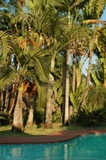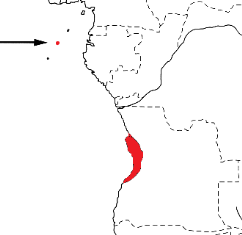Weaver species
Choose different species from drop-down list and press 'Go' button. See Full species list.Golden-backed Bishop Euplectes aureus
IUCN: Least concern Discovery: 017Categories: black and yellow bishops,
News items about species
Discovery
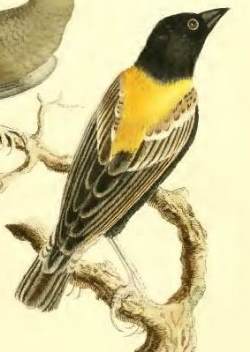
figure from Brown 1776 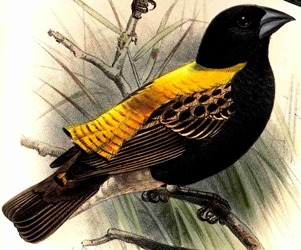
figure from Shelley 1886 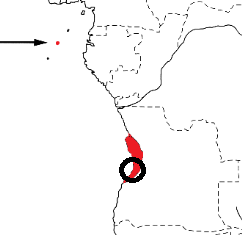
distribution, type locality circled IntroductionThe Golden-backed Bishop was formally named by Johann Friedrich Gmelin, a German naturalist. Gmelin described many new bird species in a book in 1789 in the style of Linnaeus' publications, giving a brief description in Latin and a synonomy, including a reference to Peter Brown, an English naturalist and illustrator. Gmelin noted the locality for the Golden-backed Bishop as Benguelo.Peter Brown was the first to write about, and illustrate, the Golden-backed Bishop. He called it the Golden backed Finch and gave a description of the bird. Brown notes that the bird was in the collection of Marmaduke Tunstall, an English ornithologist and collector. The bishop would have been brought by ship from coastal Angola to England, where it would have been purchased by Tunstall. Tunstall kept a pair, and possibly more birds, in captivity for several years - one bird survived for at least 8 years (Fox 1827). Scientific citationLoxia aurea Gmelin 1789 Syst. Nat., 1(2), p.846 Benguela (ex Brown, 1776, Nouv. Illustr. Zool., pl. 25), s Angola.Meaning of namesaureus (Latin): aureus, golden.First English nameThe Golden backed Finch (Brown 1776).Alternate namesGolden-backed Bishop-bird, Golden-backed Finch.CollectorUnknown.Date collectedBefore 1776, when a description was first published.Locality collectedBenguelo = Benguela, Angola.Type specimensType specimen no longer exists; the illustration of Brown 1776 serves as a type. |
The above is based on Weaver Wednesday 2, a weekly series about the discovery of each weaver species.
This species text first appeared as
Weaver Wednesday [134] - Discovery [17]: Golden-backed Bishop on 2015-01-07
1. Basic biology
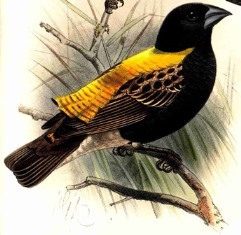
figure from Shelley 1886 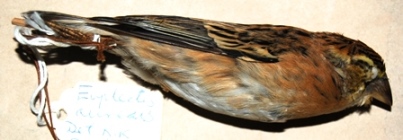
specimen in Lubango Museum Identification. The Golden-backed Bishop Euplectes aureus breeding male differs from the Yellow-crowned Bishop by a black head, from the Yellow Bishop by wholly golden orange upperparts, white wing edgings (no yellow shoulder), and a shorter tail. The female and nonbreeding male Golden-backed Bishop are distinctive with a rufous-brown breast and flanks, and the upperparts have black feathers edged rufous-brown or orange-buff. Distribution. The Golden-backed Bishop is restricted to a small area of coastal Angola, and Sao Tome Island (see map below, based on Birds of Africa). There are no subspecies of the Golden-backed Bishop. The two isolated populations suggest that this species may have been introduced from Sao Tome to Angola, or vice versa.
Habitat. The Golden-backed Bishop inhabits floodplains and rank vegetation in open acacia savanna and abandoned cotton fields, overgrown gardens with bushy cover, and tall razor-grass. In Angola it is restricted to drier lowlands below the escarpment zone. Food. The Golden-backed Bishop feeds on grass seeds and insects. It is generally found in small flocks, and often in mixed-species flocks. Breeding. The Golden-backed Bishop is polygynous. It is not colonial, but nests are clumped in groups of up to 10. The male defends his territory by singing from 3 to 4 song posts, but may also sing in flight over his territory. During courtship, the male fluffs out the long plumes of the back. The Golden-backed Bishop often nests alongside Black-winged Bishops, and males of the 2 species may share song posts. The nest is oval, with a large side entrance. It is loosely woven, with a rough outer shell incorporating living grass leaf blades. A dense inner lining of fine grass seed heads protrude above the entrance, forming a distinct porch. The nest is built by the male. The nest is hidden in grass, where it is attached to vertical grass or herb stems. The eggs (clutch 2-3) are white with fine black speckles. |
The above is based on Weaver Wednesday, a weekly series about weaver species.
This species text first appeared as
Weaver Wednesday [90]: Golden-backed Bishop on 2014-03-05
2. Breeding facts
| Pair bond Polygynous Breeding season Dec-Apr on Sao Tome Nest site attached to vertical grass stems Nest building built by male Colony size Not colonial, but nests tend to be clumped in groups of up to ten Clutch size 2-3 eggs Egg colour white with fine black speckling Egg size No information Incubation in captivity, incubation by female only, period 13-14 days Chicks and nestling period chicks fed by female alone, nestling period 15-21 days |
Breeding information based on Handbook of the Birds of the World, Vol. 15.
3. Photos of Weaver Nests
 Vm 15780 |
Thumb-nails of most recent PHOWN records - click on one to see its full record
See all PHOWN records for this species here.
PHOWN (Photos of Weaver Nests) provides valuable info on breeding distribution and colony sizes of weavers.
You can contribute by registering and submitting photos at Virtual Museum webpage.
4. Breeding distribution
Google map showing distribution (For species with small ranges you need to zoom in at the correct area to see the range):
yellow blob - range of weaver species; read more about this here.
![]() - PHOWN records with photos
- PHOWN records with photos
![]() - PHOWN records with no photos (Nest Record Cards, other records)
- PHOWN records with no photos (Nest Record Cards, other records)
![]() - Birdpix records
- Birdpix records
![]() - comments on out of range records, or interesting records
- comments on out of range records, or interesting records
![]() - type locality
- type locality
CLICK on the marker on the map to see individual record details.
5. Range changes
Not South African speciesThe above is based on Weaver Wednesday 3, a weekly series about range changes in South African weaver species.
This species text first appeared as
n/a








